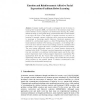Free Online Productivity Tools
i2Speak
i2Symbol
i2OCR
iTex2Img
iWeb2Print
iWeb2Shot
i2Type
iPdf2Split
iPdf2Merge
i2Bopomofo
i2Arabic
i2Style
i2Image
i2PDF
iLatex2Rtf
Sci2ools
AIHC
2007
Springer
2007
Springer
Emotion and Reinforcement: Affective Facial Expressions Facilitate Robot Learning
Computer models can be used to investigate the role of emotion in learning. Here we present EARL, our framework for the systematic study of the relation between emotion, adaptation and reinforcement learning (RL). EARL enables the study of, among other things, communicated affect as reinforcement to the robot; the focus of this chapter. In humans, emotions are crucial to learning. For example, a parent—observing a child—uses emotional expression to encourage or discourage specific behaviors. Emotional expression can therefore be a reinforcement signal to a child. We hypothesize that affective facial expressions facilitate robot learning, and compare a social setting with a non-social one to test this. The non-social setting consists of a simulated robot that learns to solve a typical RL task in a continuous grid-world environment. The social setting additionally consists of a human (parent) observing the simulated robot (child). The human’s emotional expressions are analyzed in r...
| Added | 07 Jun 2010 |
| Updated | 07 Jun 2010 |
| Type | Conference |
| Year | 2007 |
| Where | AIHC |
| Authors | Joost Broekens |
Comments (0)

